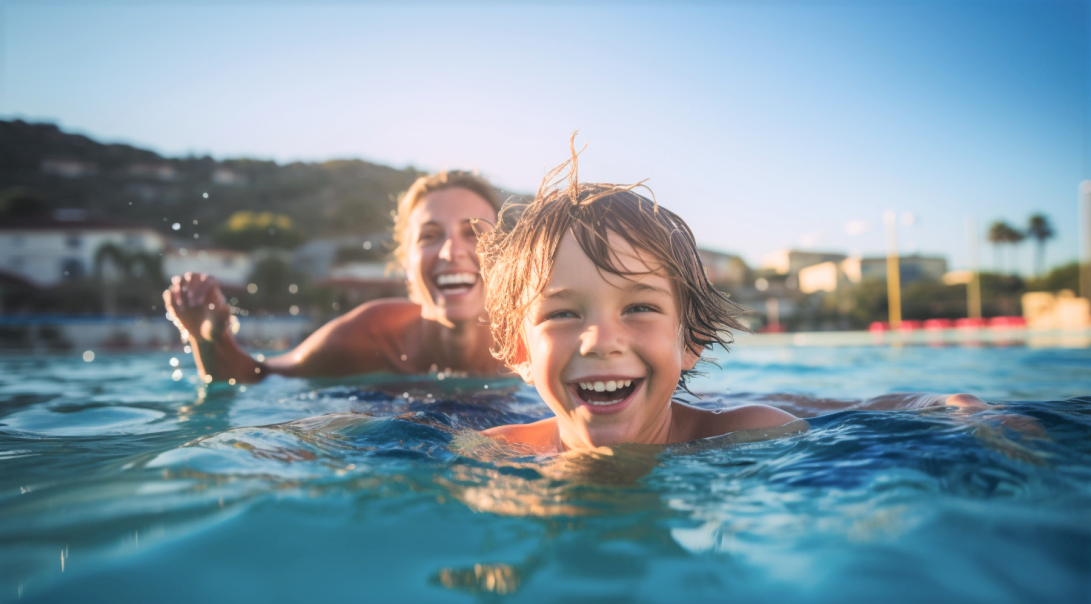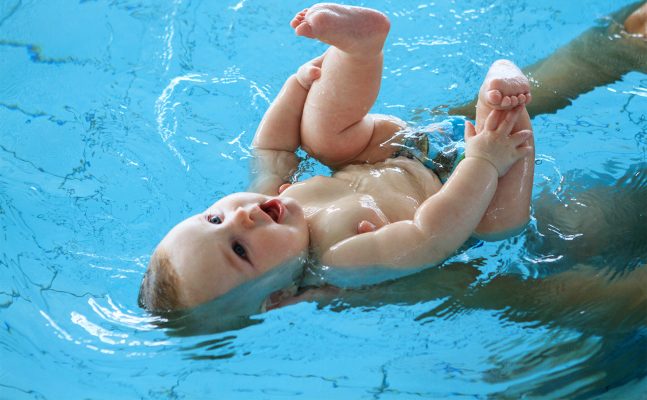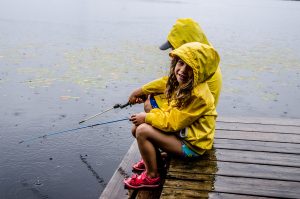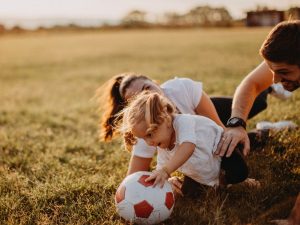Jak nauczyć dziecko pływać? Praktyczne wskazówki dla rodziców i dzieci
Spis treści:
Zrozumienie strachu przed wodą – jak pomóc dziecku pokonać lęk?
Lęk przed wodą, znany również jako akwafobia, jest jednym z najczęstszych lęków wśród dzieci. Dla wielu maluchów kontakt z wodą – szczególnie nieznanej głębokości czy w nowym środowisku, jak basen – może być źródłem niepokoju. Jak pomóc dziecku uporać się z tym strachem i cieszyć się pływaniem?
- Rozpocznij od małych kroków – nigdy nie zmuszaj dziecka do wejścia wody, lepiej zacznij od prostych ćwiczeń, takich jak bawienie się wodą w miseczce, wlewania jej z jednego naczynia do drugiego, czy też bawienie się w brodziku.
- Bądź cierpliwy – każde dziecko jest inne i może potrzebować różnej ilości czasu, by zaakceptować i poczuć się komfortowo w wodzie. Daj maluchowi czas i przestrzeń, której potrzebuje.
- Zapewnij bezpieczeństwo – upewnij się, że dziecko ma odpowiednie wyposażenie, takie jak rękawki czy kamizelka ratunkowa. Obecność tych akcesoriów może pomóc dziecku poczuć się pewniej.
- Bądź obecny – twoja obecność i wsparcie są kluczowe. Pływaj z dzieckiem, bądź tuż obok niego, śmiejąc się i bawiąc, aby pokazać, że woda to źródło zabawy, a nie strachu.
- Poszukaj profesjonalnej pomocy – jeśli twoje dziecko wydaje się być wyjątkowo przestraszone lub nie jesteś pewien, jak pomóc mu przezwyciężyć lęk, rozważ zapisanie go na profesjonalne lekcje pływania. Wielu instruktorów ma doświadczenie w pracy z dziećmi, które boją się wody, i wie, jak je uspokoić.
- Dziel się pozytywnymi doświadczeniami – opowiadaj dziecku o swoich przygodach związanych z wodą, pokaż zdjęcia lub filmy z wakacji nad wodą. Pokaż, że woda to nie tylko basen, ale także morze, jezioro czy rzeka – miejsca, gdzie można spędzać czas i cieszyć się chwilą.
- Nie bagatelizuj uczuć dziecka – ważne jest, aby nie ignorować czy umniejszać uczuć dziecka. Jeśli wyraża obawy lub strach, rozmawiaj o tym i próbuj zrozumieć, skąd się bierze ten lęk.
Pamiętaj, że strach przed wodą jest naturalny, ale z właściwym podejściem i wsparciem możesz pomóc swojemu dziecku pokonać ten lęk i odkryć radość z pływania.
Wybór odpowiedniego sprzętu do nauki pływania
Nauka pływania to nie tylko kwestia techniki i wprawy, ale także wyboru odpowiednich narzędzi wspomagających proces. Dla dziecka, które dopiero zaczyna przygodę z wodą, właściwie dobrany sprzęt może być kluczem do sukcesu.
1. Rękawki do pływania
To dwie komory powietrzne umieszczone na ramionach dziecka, które zapewniają mu dodatkową wyporność. Dzięki nim dziecko może skoncentrować się na machaniu nogami i na nauce prawidłowego oddechu, nie martwiąc się o utrzymanie się na powierzchni wody. Sprawdzą się one dla początkujących maluchów, które dopiero uczą się podstaw pływania.
2. Deski do pływania
Płaska lekka deska z tworzywa sztucznego, którą dzieci mogą trzymać przed sobą. Umożliwia skoncentrowanie się na pracy nóg oraz doskonalenia techniki pływania. Deski świetnie sprawdzą się dla dzieci, które uczą się stylu klasycznego czy dowolnego.
3. Pasy wypornościowe
Pas umieszczony wokół talii dziecka zapewnia wyporność, dając przy tym większą swobodę ruchów niż rękawki. Dziecko może swobodnie machać rękoma i nogami. Warto zastosować go wówczas, gdy dziecko zaczyna czuć się pewniej w wodzie i chce doskonalić technikę pływania.
4. Pianki pływackie
Długie, elastyczne pałki z pianki, które można stosować na różne sposoby – pod pachami, między nogami lub jako wsparcie pod plecami. Mogą być używane do różnych ćwiczeń i adaptacji do wody. Można stosować je u dzieci na każdym etapie nauki pływania, w zależności od konkretnego ćwiczenia.
Przy wyborze odpowiedniego sprzętu warto kierować się nie tylko wiekiem dziecka, ale przede wszystkim jego umiejętnościami i stopniem pewności siebie w wodzie. Pamiętajmy, że bezpieczeństwo jest priorytetem, więc wszelki sprzęt powinien być zgodny z normami bezpieczeństwa i regularnie kontrolowany pod kątem ewentualnych uszkodzeń.
Pierwsze kroki w nauce pływania – ćwiczenia i zabawy na płyciznach
Nauka pływania może być równie fascynująca, co wymagająca, zwłaszcza dla najmłodszych. Jednak, jak w wielu dziedzinach życia, kluczem do sukcesu jest zabawa i stopniowe wprowadzanie do nowych umiejętności. Oto kilka ćwiczeń i zabaw, które możesz wykorzystać na początek przygody z pływaniem, prowadząc je na płyciznach:
- Mokre dłonie – zachęć dziecko, aby moczyło dłonie w wodzie i robiło nimi „klaski”, chlapiąc wodą. Celem tego ćwiczenia jest aklimatyzacja z wodą i przekonanie się, że może być ona źródłem zabawy.
- Szukanie skarbów – wrzuć na dno basenu na płyciznach kilka kolorowych przedmiotów (np. plastikowe zabawki) i zachęć dziecko do ich podnoszenia. Celem tego ćwiczenia jest zachęcenie do zanurzania głowy i praktykowanie otwierania oczu pod wodą.
- Podwodne bańki – naucz dziecko wydmuchiwać powietrze pod wodą, tworząc bańki. Celem tego ćwiczenia jest nauka prawidłowego oddychania.
- Krok po kroku – zachęcaj dziecko do chodzenia po płyciznach, od jednego końca basenu do drugiego. Celem tego ćwiczenia jest wzmacnianie pewności siebie w wodzie i ćwiczenie równowagi.
- Balonik – poproś dziecko, aby wzięło głęboki oddech i utrzymywało się na powierzchni wody jak napełniony powietrzem balonik. Celem tego ćwiczenia jest nauka wyporności i zrozumienie, jak powietrze w płucach pomaga utrzymać się na powierzchni.
- Kaczuszki w kółeczku – utwórz z grupą dzieci krąg i śpiewajcie piosenki o kaczkach, poruszając się razem po płyciznach. Celem tego ćwiczenia jest wzmacnianie ducha grupowego, nauka koordynacji i przyzwyczajenie do wody.
Kiedy wprowadzasz dziecko w świat pływania, kluczową sprawą jest cierpliwość i pozytywne wzmocnienie. Zachęcanie, pochwały i okazywanie radości z każdego postępu pomogą budować pewność siebie u twojego dziecka i uczynią cały proces nauki przyjemniejszym i bardziej satysfakcjonującym.
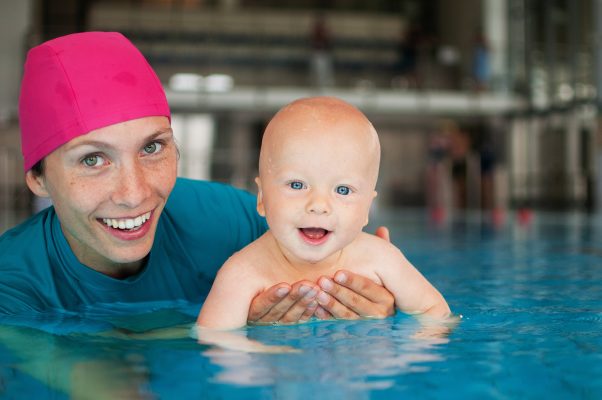
Jak utrzymać motywację dziecka? Wskazówki dla rodziców
Motywacja w nauce pływania jest tak samo ważna, jak sama technika. Dla wielu dzieci początek przygody z basenem bywa fascynujący, ale z czasem, kiedy pojawiają się trudności, entuzjazm może nieco opaść. Dlatego niezwykle ważną rolę w procesie nauki odgrywają rodzice, którzy mają wpływ na utrzymanie pozytywnego podejścia dziecka do pływania.
Zdefiniowanie i ustalanie małych, osiągalnych celów jest jednym ze sposobów na utrzymanie zainteresowania. Kiedy dziecko osiąga taki cel, warto je nagradzać, niekoniecznie materialnie – często słowo uznania po ciężkim treningu będzie wystarczające.
Nie bez znaczenia jest też stałe podkreślanie postępów, które dziecko czyni, nawet jeśli są one niewielkie. Akcentowanie tego, co poszło dobrze, a nie skupianie się na błędach, pozwoli budować pewność siebie i zrozumienie wartości wysiłku włożonego w naukę. Rodzice powinni być też obecni podczas lekcji pływania, jeśli to możliwe. Obserwowanie postępów, a także bycie częścią tego doświadczenia, pokazuje dziecku, że jesteśmy zainteresowani jego rozwojem i że jesteśmy z niego dumni.
Co więcej, warto pamiętać, że pływanie to nie tylko nauka, ale przede wszystkim zabawa. Organizowanie dni, podczas których cała rodzina spędza czas na basenie, bez konieczności ćwiczeń czy nauki, pomoże przypomnieć dziecku, jaką radość może przynieść pływanie.
W miarę postępów warto też zachęcić dziecko do dołączania do grup pływackich lub klubów. Spotkanie innych młodych pływaków, wymiana doświadczeń i poczucie przynależności do grupy mogą być kolejnym źródłem motywacji. Nie zapominajmy również o rozmowach z dzieckiem na temat korzyści płynących z umiejętności pływania – nie tylko tych zdrowotnych, ale również tych związanych z bezpieczeństwem i radością z aktywności fizycznej.
Na koniec warto podkreślić, że cierpliwość jest fundamentem. Każde dziecko będzie miało chwile zwątpienia. W tych momentach wsparcie rodzica, zrozumienie i zachęta stanowią nieocenioną wartość, która może wpłynąć na dalszy rozwój umiejętności pływackich dziecka.
